Whether you are a beginner or an experienced dirt bike rider, there is no way you can avoid learning how to ride a manual transmission dirt bike. To effectively ride a clutch dirt bike, you need to learn:
- Getting your bike into neural
- Igniting the clutch dirt bike engine
- Shifting into first gear
- Gently Releasing the Clutch and Accelerating
- Avoiding Stalling
This how-to post will walk you through the basic steps of the process, which will help you improve your riding skills.
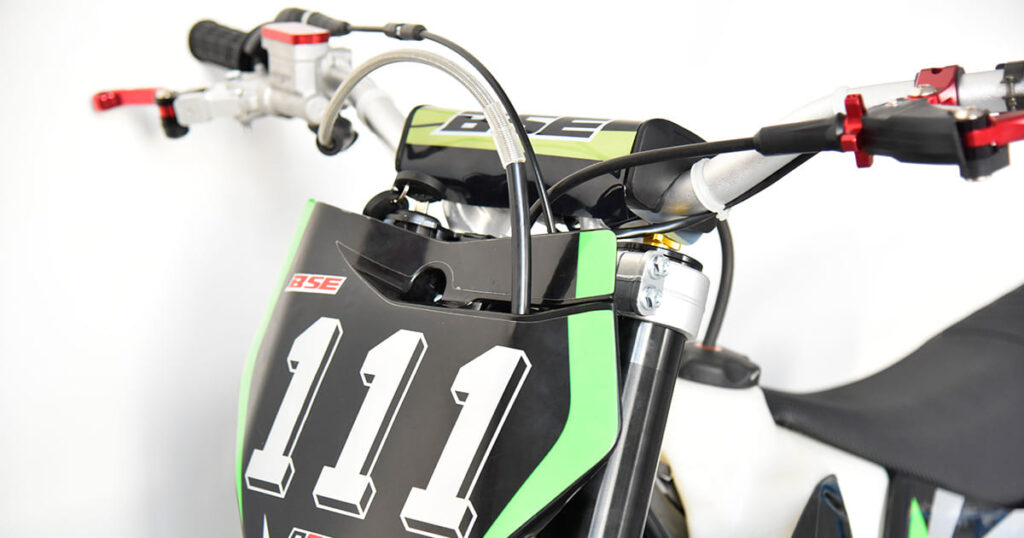
How To Ride a Dirt Bike with a Manual Clutch?
Riding a clutch dirt bike is a thrilling activity that is a blend of skill and practice. In this section, we’ll explore the essential steps to help you ride like a pro.
Step 1: Get into neutral
To get your dirt bike ready to start, you have two options. First, put the bike in neutral and release the clutch before starting it. Second, you can put the bike in first gear and hold the clutch while starting.
The second option works best after you’ve been riding for a while because the clutch’s temperature rises and it expands, it starts to spin without resistance. When the bike is cold, the plates stick a bit, making it hard to start in gear. So, we will focus on the simplest method that is the first one.
Hold the clutch lever and use the gear lever near the left footpeg to find neutral. Push the lever down to reach the first gear, then lift it gently to locate neutral, which lies between the first and second gear.
For beginners finding neutral can be tricky, but with practice, you will get used to it. Each bike has a different neutral feel, and some have different gear configurations, so learn the direction of the first gear on your manual dirt bike.
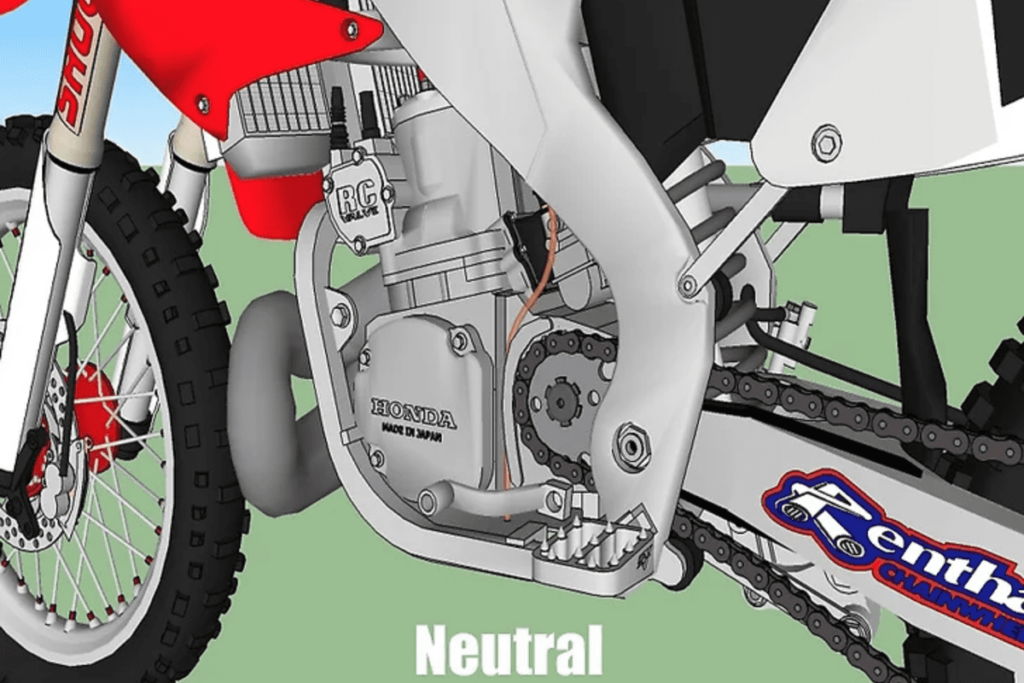
Step 2: Ignite the Clutch Dirt Bike’s Engine
Start the bike once it’s in neutral. You might need to kickstart it or use an electric starter. Ensure the kickstand is up, as some bikes won’t start with it down. When the engine runs, you can proceed to ride.
Step 3: Shift into First Gear
To start moving the manual dirt bike, shift into first gear while keeping the clutch lever fully squeezed. If you don’t hold the clutch in enough, the bike might jerk and stall when you engage the gear. With the clutch in, use your left foot to press down on the gear lever in front of the left footpeg. You’ll hear a sound indicating that the bike is now in first gear. You’re now ready to start riding.
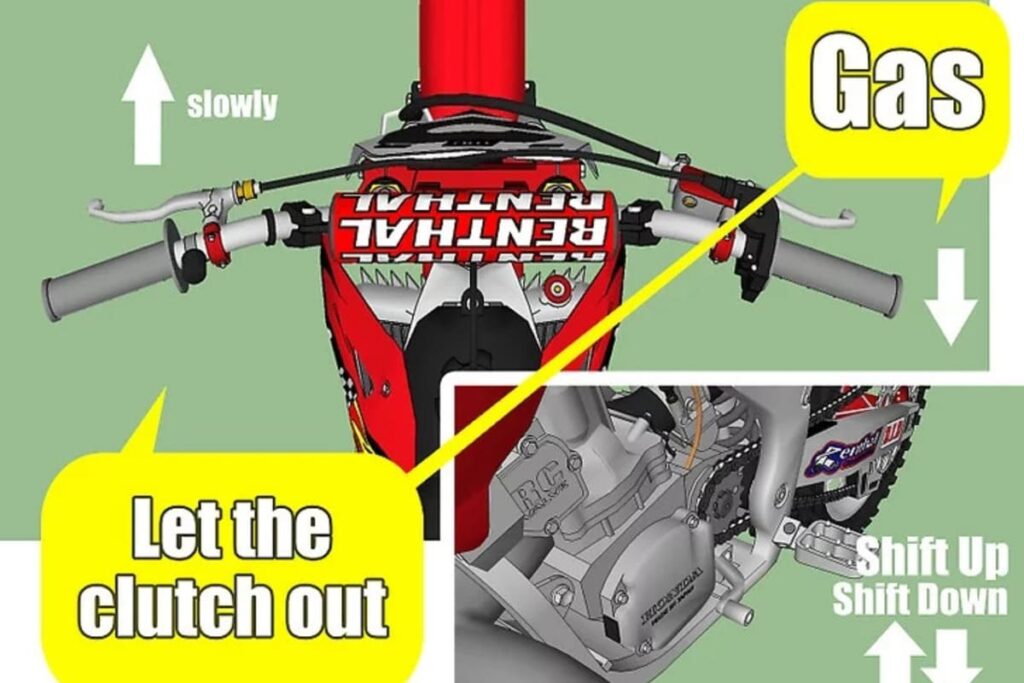
Step 4: Ease the Clutch Lever Out and gently accelerate
As in the car, slowly let go of the clutch while providing the bike some throttle. If you let go of the clutch quickly, the bike will stall. If you give too much gas, the bike will lurch and you can easily fall off. The trick is to ease the clutch out while at the same time applying gas.
If you are doing it right you are gliding and probably applying more throttle. As you do this, you will see the engine RPMs increase but the bike will not move at a faster speed. If the revs are too low, then add more gas to avoid the engine from stalling. Do not allow the revs to rise too high, or the bike will move too fast. Manage the acceleration; if it gets out of hand, pulling in the clutch will help control the speed.
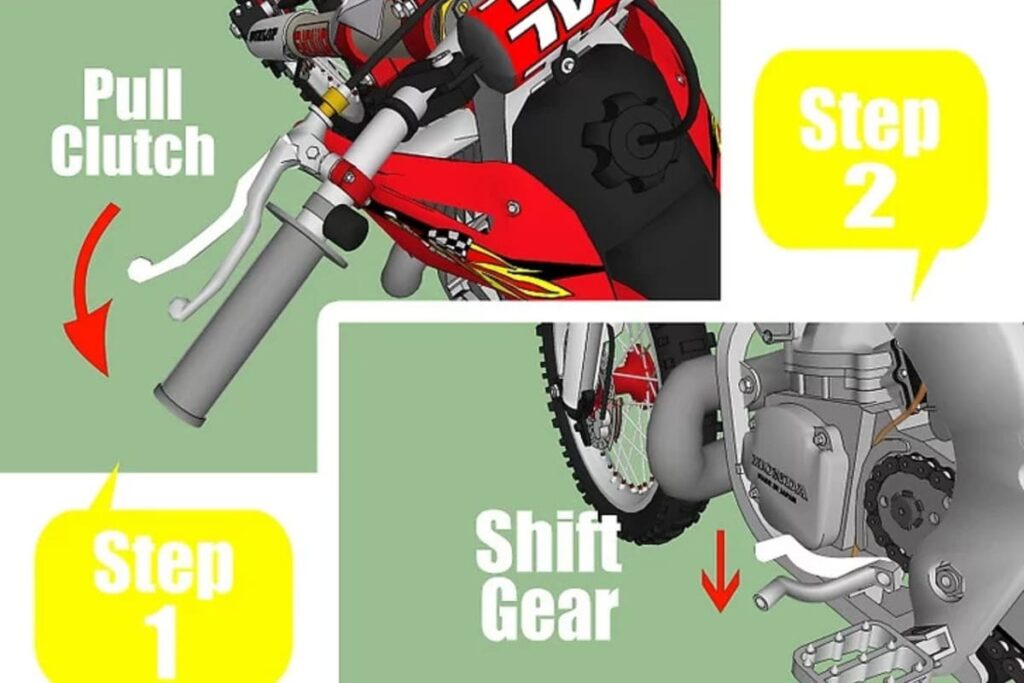
Step 5: Avoiding Stalling
Stalling is when the engine is no longer running due to improper synchronization of the clutch and the throttle. This is something beginners experience but can be avoided. Ensure that you give the bike enough gas as you let go of the clutch.
It is always challenging to learn how much throttle is necessary. If you stall, do not worry. All you need is to engage the clutch, switch off the engine, then switch on the engine and attempt the process again. The more you do it and the more time you spend practicing, the better you will be at it.
Step 6: Slow Down and Stop
To bring your bike to a halt, you must put it in neutral. Start by shifting to the first gear then easing the shifter to engage the neutral gear. However, if you apply too much pressure, you may end up changing the gear to the second gear instead. Since there is no signal to mark the beginning of neutral, it is crucial to learn how to feel for it.
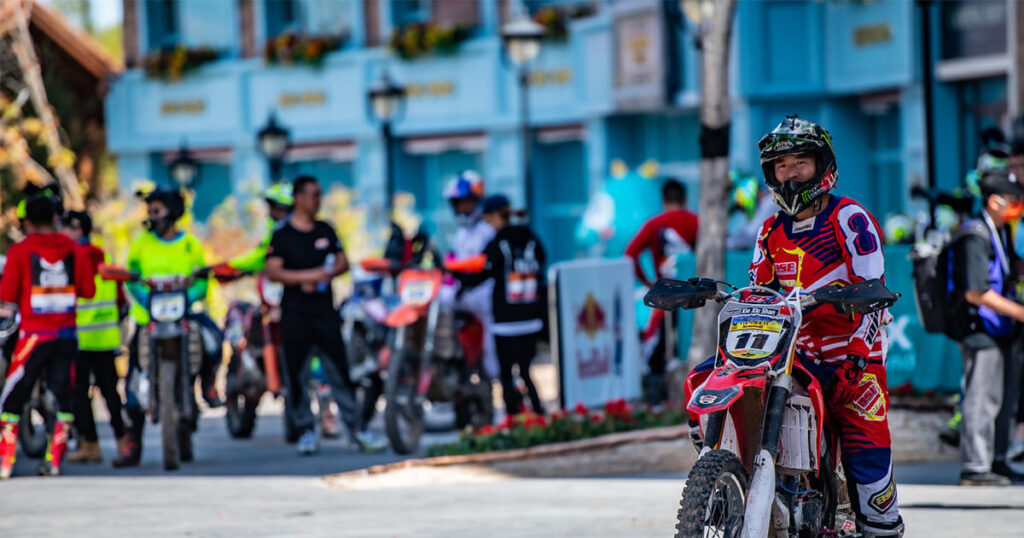
How to Shift a Manual Dirt Bike as A Beginner?
It is quite an achievement to get the dirt bike going with the first gear. After that, you will also need to understand how to shift to the higher gears as you gain speed.
Now, attempt to move to the second gear. Depress the clutch pedal and shift up, then take your foot off the clutch pedal. You do not need to be as cautious as you were when changing from the neutral gear to the first gear.
Do the same for shifting from second to third gear and so on up to the fifth gear of the gear stick. Always pull in the clutch lever when you are shifting the gear. Typically, bikes are fitted with five gears but there may be as few as four or as many as six. If you do not use the clutch when changing gears, you will hear a grinding sound from the transmission and this is a sign that it may be time to change it.
Gradually, you will know how to use a clutch on a dirt bike with much confidence. The skills you will learn during the process will feel natural in subsequent rides.
Downshifting
To downshift, use your foot to press the lever down instead of pulling it up. This can be the hardest part of learning to shift manually on a dirt bike. Shifting can also be a problem when wearing a boot, which is not as flexible as sneakers. Like any other skill, the more you practice and repeat the skill, the better you become.
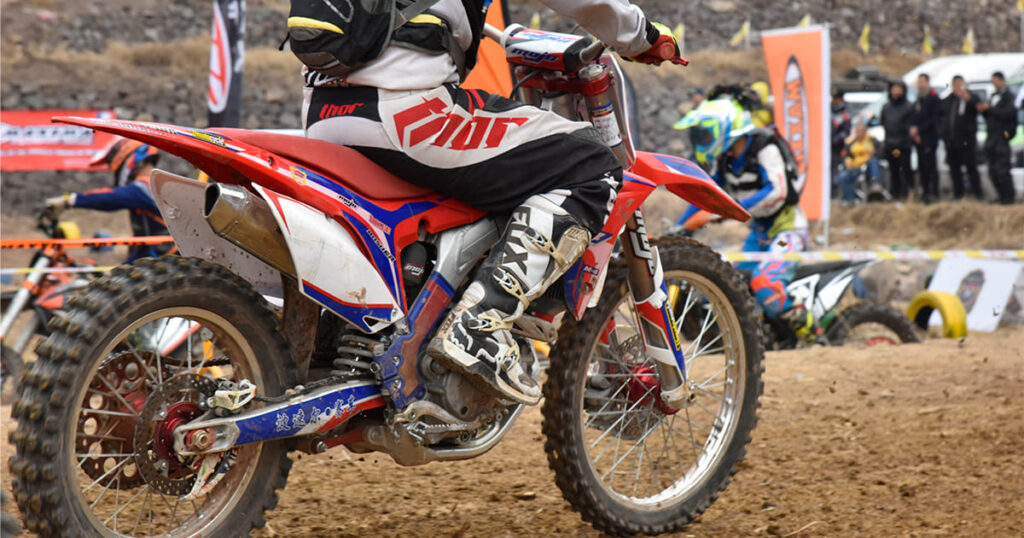
When Riding a Clutch Dirt Bike?
Adjusting Your Clutch Lever Of Your Manual Dirt Bike
To ensure comfortable and accurate operation, adjust your clutch lever properly. Make sure the lever is positioned at a comfortable reach that does not force one to extend their fingers to pull it in or it is too near to the body. The ideal distance should allow you to push and release the clutch without strain and with as much control as possible over the bike.
Maintain and Service Your Clutch
The clutch system should be checked often to ensure it is in good working condition. Look for wear or damage on the clutch cable or the hydraulic system if it is used. Grease the parts of your bike that experience friction as often as you can and change the clutch fluid if your bike is fitted with a hydraulic clutch. Be aware of any strange sounds or shifts in the way the clutch feels, as these could be signs of wear or mechanical problems.
Perfecting One-Finger Clutch
One-finger operation of the clutch lever helps prevent hand fatigue. For this technique to be effective, adjust the clutch lever to fit the size of your hand and the strength you need to operate it. To get familiar with the sensitivity and response of your bike, try to engage and disengage the clutch with the help of only one finger. This technique makes it possible to achieve quicker and more accurate control, particularly in technical riding scenarios where frequent changes to the clutch are required.
Seek Professional Training
If you like dirt biking, you can join a local motorcycle rider training. This type of course will help you to learn the proper way of doing it and the necessary safety measures. It is always good to learn from experts because this way, you get the best advice. With their help, you will build confidence and develop your skills much faster.
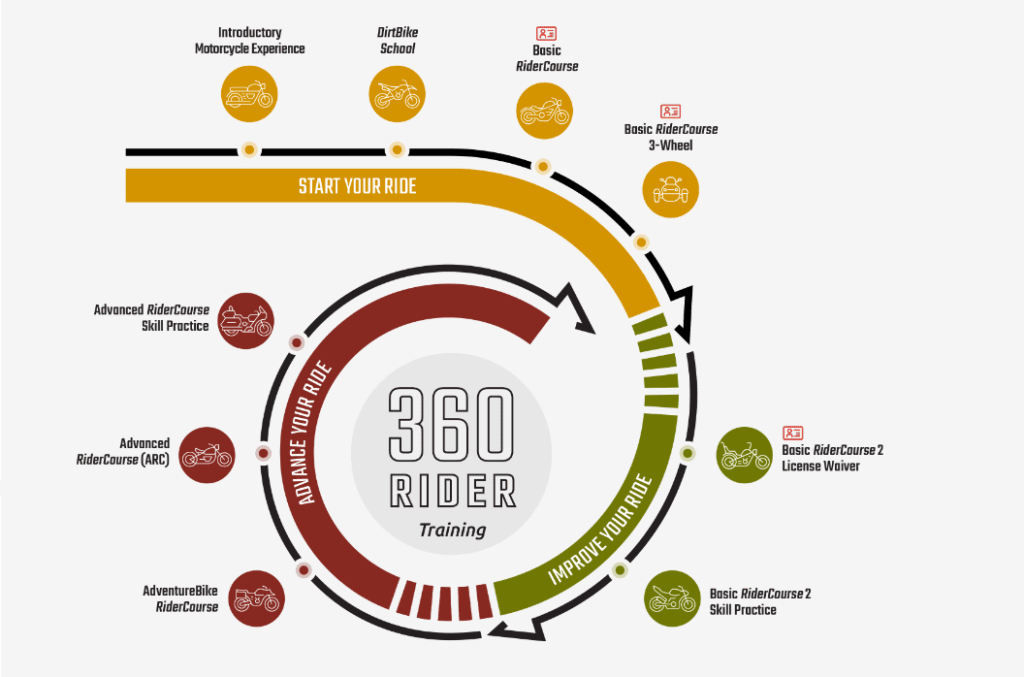
Protect Your Manual Dirt Bike: Always Use the Clutch When Shifting Gears
The clutch on a manual dirt bike serves an important purpose: it disengages the engine from the transmission when you are shifting the gears. This separation aids in preventing the transmission from getting damaged during gear shifts.
Some riders prefer to change gears without the clutch but this is a risk that requires a lot of practice. This technique should not be used by novices as it poses a high risk of damaging the transmission. Lack of proper use of the clutch may lead to severe damage and costly repairs.
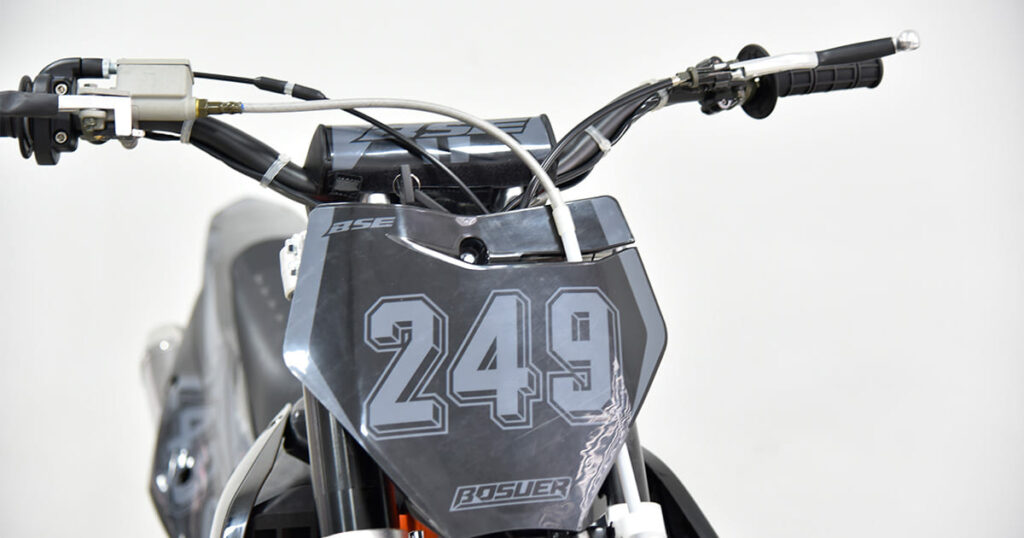
Automatic Dirt Bike Vs Manual Dirt Bike
If you do not prefer to ride a manual dirt bike, then an automatic dirt bike is ideal for you. Automatic bikes are easy to ride because you do not have to shift gears by yourself. This means that you can spend less time shifting gears and more time enjoying the ride. Automatic bikes also give a comfortable ride since the engine power is adjusted according to the speed. This can be particularly useful for new riders or those who want to master the controls of the bike and how to maneuver through the rough terrain without having to learn how to shift between the gears manually.
Bse Motor Dirt Bikes
Bosuer is a global leading dirt bike manufacturer that provides a comprehensive range of off-road motorcycles that operate in over 50 countries. Here you will find a variety of wholesale dirt bikes with clutch for different classes of riders, with high safety and excellent performance. You can opt for your desired manual dirt bike among so many options.
All of our dirt bike models are test real-field competitions. During production, Bosuer uses 52 processes and 28 tests to ensure quality requirements of the riders, dealers, and brand owners are met satisfactorily. If you are looking for a reliable dirt bike supplier, then do not hesitate to contact Bosuer.
Conclusion
Riding a clutch dirt bike can be tough in the early days. You might stall the bike several times and consider switching to an automatic. However, with a bit of practice and patience, you can learn to ride and shift gears smoothly. Spend a few hours practicing, and you’ll start to improve quickly. The key is to keep trying and staying focused, and you’ll soon know how to ride a dirt bike with a clutch.
